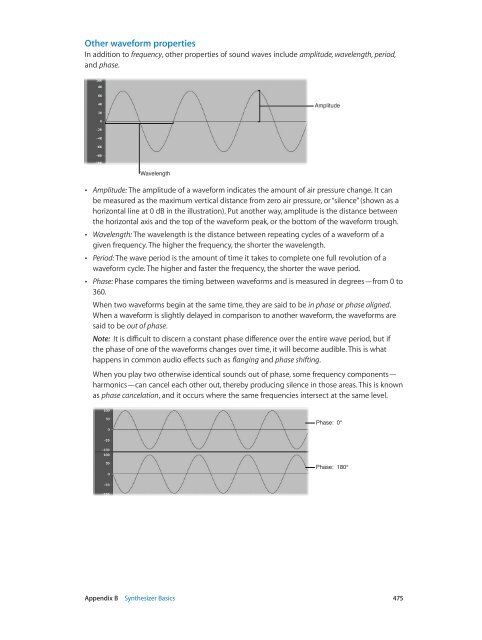Apple MainStage 3 Instruments - MainStage 3 Instruments
Apple MainStage 3 Instruments - MainStage 3 Instruments
Apple MainStage 3 Instruments - MainStage 3 Instruments
Create successful ePaper yourself
Turn your PDF publications into a flip-book with our unique Google optimized e-Paper software.
Other waveform properties<br />
In addition to frequency, other properties of sound waves include amplitude, wavelength, period,<br />
and phase.<br />
Amplitude<br />
Wavelength<br />
••<br />
Amplitude: The amplitude of a waveform indicates the amount of air pressure change. It can<br />
be measured as the maximum vertical distance from zero air pressure, or “silence” (shown as a<br />
horizontal line at 0 dB in the illustration). Put another way, amplitude is the distance between<br />
the horizontal axis and the top of the waveform peak, or the bottom of the waveform trough.<br />
••<br />
Wavelength: The wavelength is the distance between repeating cycles of a waveform of a<br />
given frequency. The higher the frequency, the shorter the wavelength.<br />
••<br />
Period: The wave period is the amount of time it takes to complete one full revolution of a<br />
waveform cycle. The higher and faster the frequency, the shorter the wave period.<br />
••<br />
Phase: Phase compares the timing between waveforms and is measured in degrees—from 0 to<br />
360.<br />
When two waveforms begin at the same time, they are said to be in phase or phase aligned.<br />
When a waveform is slightly delayed in comparison to another waveform, the waveforms are<br />
said to be out of phase.<br />
Note: It is difficult to discern a constant phase difference over the entire wave period, but if<br />
the phase of one of the waveforms changes over time, it will become audible. This is what<br />
happens in common audio effects such as flanging and phase shifting.<br />
When you play two otherwise identical sounds out of phase, some frequency components—<br />
harmonics—can cancel each other out, thereby producing silence in those areas. This is known<br />
as phase cancelation, and it occurs where the same frequencies intersect at the same level.<br />
Phase: 0°<br />
Phase: 180°<br />
Appendix B Synthesizer Basics 475
















